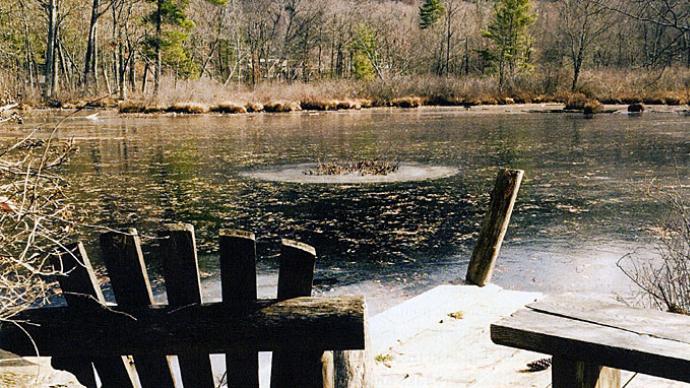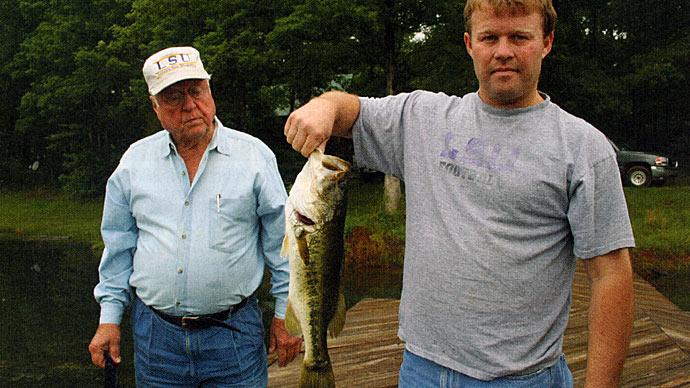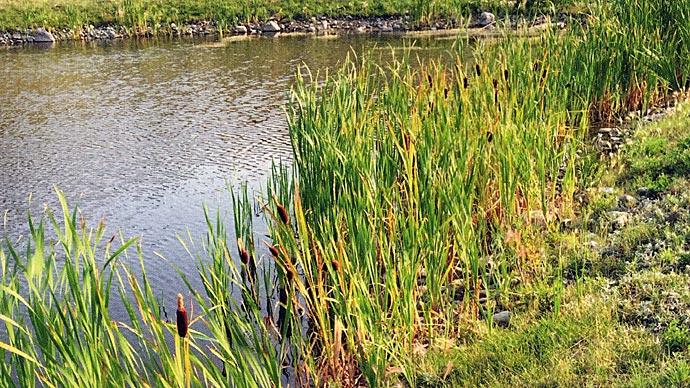
And if the perfect pond exists, what would it look like? What fish would lie beneath the waters sparkling in the sun soaked surface? Would its shore be lined with rows of perfect diameter white birches, turned flame yellow and orange by a frosty fall sun? Would a cane pole be peeking out of a varnished wooden row boat at the end of a long floating dock? Would trout as long as your arm boil in anticipation of food as you bang a coffee can of food on the dock edge, like a textbook lesson from Pavlov's dogs? You and your youngster dangle your feet in the pond's cool waters on a hot summer day. Are monster bucketmouth bass lurking shadows watching your toes? You run and jump off the dock in a flying leap, the cool, deep water closes over your head and your feet never touch bottom.
In my mind's eye, this is the perfect northern aesthetically pleasing. Be honest with yourself Largemouth in your half-acre pond? Not likely, pond. What is your dream pond like? What about your goals. Can you produce a state record but it can produce some very enjoyable bass fish - can you do to make that dream a reality?
Let's start with something simple. When you dream of your perfect pond, is it full offish? Or, don't you care? I am often surprised that many people who enjoy ponds immensely do not necessarily care about fish. I have a preconceived notion that all pond owners want (maybe need?) fish, but I am often wrong about this. Some people want a healthy pond that looks well-balanced and natural, or in other words, they really want their pond to be aesthetically pleasing. If fish are a part of that mix, so be it. On the opposite end of the pond spectrum are those folks that want to maximize fish production. In this pond, the owners and their family want to go down to the pond and catch good quantities of large sportfish. However, this sportfish pond might look much different than the pond that is the most aesthetically pleasing. Be honest with yourself about your goals. Can you produce a state record Largemouth in your half-acre pond? Not likely, but it can produce some very enjoyable bass fishing for you and your family.

The perfect depth depends on what you want in your pond. A deep, open water pond might be great for swimming and for trout to hide in the cool depths. But, a shallow pond is more productive, because a larger amount of the pond's bottom is in the photic zone (or the zone of light penetration). The pond food chain starts with a green plant, and more green plants grow in the shallow depths where the bottom of the pond is in this zone of shallow production. Want plants? Dig a shallow pond. Want a limited amount of plants? Then make the banks of the pond steep, quickly plunging off to 8 feet or more in depth, and this will give you a very abbreviated rooted plant zone. Additionally, a pond in the north needs to have sufficient depth to overwinter your fish. As a result, I would not recommend digging a pond less than 8 feet deep. If you want trout, the pond should be even deeper, with a good amount of the pond's volume (more than 1/3) greater than 10 feet deep. Why so deep? In deep winter, the pond must have the depth to hold oxygen through the winter for the fish to survive under the ice. Shallow, productive ponds routinely winterkill. Trout need cold water to survive the summer and require even deeper ponds.
Given all of the variables, what is a good pond depth in the north? I'd say for a normal, 1-2-acre pond with an elevation 500-1500 feet above sea level, dig the pond 10-12 feet deep. Over time, the pond will fill in and you will be happy you dug a deep pond. Shallow ponds ARE more productive, but they will routinely winterkill and likely winterkill at least once every three years in addition to being weed-choked. Emergent plants like cattails and rushes will grow in less than three feet of water. Submerged and floating-leaved plants will grow in less than six feet of water. These plants are good for the pond but should not dominate. A good rule of thumb for a well-balanced pond is that no more than 50% of the surface area of the pond be covered with plants. This means 50% open water. Another way to think about this is that at least 50% of the pond needs to be seven feet or more to avoid excessive weed growth dominating the pond. However, it is okay (and even advantageous) to have some shallow areas in the pond. These shallow areas will warm fast and will be important for baitfish like fathead minnows to spawn.
As I mentioned before, I don't recommend building a pond shallower than 8 feet deep in the north. Sufficient depth is necessary to overcome the threat of winterkill. Oxygen gets into the pond primarily by diffusion from the atmosphere and through photosynthesis from green plants. Ice stops the diffusion process and snow piled on the ice slows photosynthesis. A pond needs to store oxygen from the time the ice forms on the pond until it melts, roughly December to March, and an 8-foot depth is considered a minimum to store enough oxygen from December to March.

What is the perfect size? I love big ponds, but the better question might be, how complex should the pond be? Different species offish are like workers with different professions. These professions are the niches those fish occupy. For example, a Largemouth bass is a roving predator of the weedy edges. A bullhead is a bottom oriented, opportunistic omnivore, a bluegill picks invertebrates off plants, a fathead minnow is a generalist, shallow water baitfish, and so on. Here's the thing: The more complex the pond's habitats, the more niches there are. Generally, there isn't room for more than one species to fill each niche in your pond. This concept in ecology is generally thought of as the competitive exclusion principle. This is a tenet that says two different fish species cannot occupy the same niche, because they are competing for the same resources. One fish species will eventually exploit the resources better than the other and win out. Why do you care? Greater habitat diversity in your pond will yield more niches and increase the number offish species. If you want fish diversity, build a big pond with big diversity. This means some shallow water, some gravel in the shallows, some shallow soft substrates for weeds and emergent plants, some flat rocks in the shallows, some deep boulders, some submerged woody debris, some deep water, and then some even deeper water. More diverse habitat equals more niches, resulting in greater fish diversity.
Most pond owners want a mixed-use pond. Like me, they want it all. That means some serious effort and planning must to go into the pond design. Nice ponds very rarely just happen. Here is my advice on this. Sit down and make a list of your top 5 pond dreams. Our pond went like this: (1) Aesthetics. (2) Fishing for a fun species of fish with kids. (3) Swimming for people, dogs, and horses. (4) Wildlife habitat (5) Emergency water source. To us this meant a pond (1) Larger than an acre. (2) Deeper than 10 feet. (3) Less than 25% plant coverage accomplished by steep sides on a 2:1 or 3:1 slope. (4) Habitat for smallmouth and panfish to breed in the gravel benches around some of the perimeter. (5) A shallower area on one shore for dogs and horses to swim. (6) A floating dock to get out of near shore weeds, and a platform in the middle of the pond for swimming. (7) Near shore flat rocks for fathead minnows to spawn under. Luckily for us, nothing on our list was contradictory, and many items were in fact complementary.
One last piece of advice. Despite your dreams, the person driving the bulldozer is the one who builds the pond. Spend some time vetting your pond builder like you would other contractors—or even a doctor. This is definitely worth your time. Ask for references, and make a visit to a pond or two that they have built on similar soils. Ask the owner of the pond how the contractor did on the job. Was the owners vision accomplished by the builder? What was the interaction like during construction? Specifically, did the builder incorporate the owner's ideas into the pond? Good planning and working with a great pond builder are what make dreams a reality.
What does your dream pond look like?
Reprinted with permission from Pond Boss Magazine



